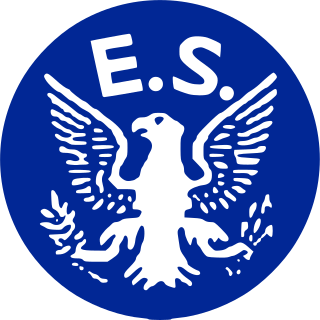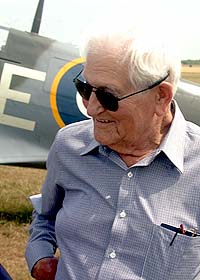Biography
François de Labouchere was one of the first pilots to join the Free French Air Force. He was a cadet pilot at the time of the Battle of France, during which his father (a cavalry officer) died. He was in Morocco when the armistice arrived. Going via Gibraltar, he then returned to England, where he met up with his college friend Émile Fayolle.
Appointed as a warrant officer in September 1940, he was posted to No. 85 Squadron in company with Fayolle. In March 1941, promoted to 2nd lieutenant, he was posted to No. 242 Squadron, where Philippe de Scitivaux and Bernard Dupérier were found, still with Fayolle. In July, sacrificing his leave, he was posted at his request to No. 615 Squadron where René Mouchotte and Jean Maridor were stationed. In November 1941 he was posted to the Île-de-France fighter group, the No. 340 (Free French) Squadron, where he became captain and commander of the Versailles squadron on 1 August 1942. On 19 August, the day of the attack on Dieppe, his friend Fayolle disappeared. On 5 September, Labouchère disappeared in turn, during air-to-air combat. His body has never been recovered. He took off at 09.30 (BST) as Yellow 1 in Spitfire BL803/GW-L (TNA, AIR 27/1737/20, Form 541, 340 Squadron, September 1942) and was shot down by JG 26 pilot after 11.30 hours (GST).

Air Vice Marshal James Edgar Johnson,, DL, nicknamed "Johnnie", was an English Royal Air Force (RAF) pilot and flying ace who flew and fought during the Second World War.

The Eagle Squadrons were three fighter squadrons of the Royal Air Force (RAF) formed with volunteer pilots from the United States during the early days of World War II, prior to America's entry into the war in December 1941.
Karel Miloslav Kuttelwascher DFC and Bar was a Czech fighter pilot, and a flying ace of the UK's Royal Air Force (RAF) in the Second World War. He was in combat service from May 1940 to October 1942, first with the French Air Force and then with the RAF.

No. 303 Squadron RAF was one of two Polish squadrons to fight during the Battle of Britain along with squadron 302, of 16 total Polish squadrons in the Royal Air Force (RAF) during the Second World War. Flying Hawker Hurricanes, the squadron claimed the largest number of aircraft shot down of the 66 Allied fighter squadrons engaged in the Battle of Britain, even though it joined the fray two months after the battle had begun.

Group Captain John Alexander "Johnny" Kent,, nicknamed "Kentski" by his Polish comrades, was a Canadian fighter ace flying in the Royal Air Force during the Second World War. Considered one of the best young squadron leaders of the war, he went on to a distinguished postwar career before entering the aviation industry.

Zygmunt Witymir Bieńkowski was a Polish pilot and a writer of many articles and poems. His 303 squadron diary is held in the Polish Museum and Sikorski Institute in London.

Air Vice Marshal William Vernon Crawford-Compton, was a New Zealand flying ace of the Royal Air Force (RAF) during the Second World War. He was officially credited with destroying at least 20 enemy aircraft.

Duane Willard Beeson was an American fighter pilot and flying ace of World War II. He scored 22.08 victories, including 17.3 air-to-air kills, 12 of which were scored in the P-47C/D Thunderbolt, and 5.3 of which were scored in the P-51-B Mustang. Beeson was one of ten United States Army Air Forces pilots who became an ace in two different types of fighter aircraft.

Wing Commander Brendan Eamonn Fergus Finucane,, known as Paddy Finucane amongst his colleagues, was an Irish Second World War Royal Air Force (RAF) fighter pilot and flying ace—defined as an aviator credited with five or more enemy aircraft destroyed in aerial combat.
Flying Officer George Noel Keith was a Second World War Canadian fighter pilot and flying ace.

Marcel Albert was a French World War II flying ace who flew for the air forces of the Vichy government and the Free French forces, and also for the Soviet Air Force and the Royal Air Force. He was born in Paris.

James Harry Lacey, was one of the top scoring Royal Air Force fighter pilots of the Second World War and was the second highest scoring RAF fighter pilot of the Battle of Britain, behind Pilot Officer Eric Lock of No. 41 Squadron RAF. Lacey was credited with 28 enemy aircraft destroyed, five probables and nine damaged.

Flight Lieutenant James Henry Whalen was a Canadian Second World War fighter pilot ace.

Donald James Matthew Blakeslee was an officer in the United States Air Force, whose aviation career began as a pilot in the Royal Canadian Air Force flying Spitfire fighter aircraft during World War II. He then became a member of the Royal Air Force Eagle Squadrons, before transferring to the United States Army Air Forces in 1942. He flew more combat missions against the Luftwaffe than any other American fighter pilot, and by the end of the war was a flying ace credited with 15.5 aerial victories.
Wilhelm-Ferdinand "Wutz" Galland was a German Luftwaffe military aviator and fighter ace during World War II. He is credited with 55 aerial victories achieved in 186 combat missions. All his victories were claimed over the Western Front and in Defense of the Reich. This figure included seven four-engine bombers and 37 Supermarine Spitfire fighters.

Antoni (Toni) Głowacki DFC, DFM, was a Polish Second World War fighter pilot flying with Polish Squadrons attached to the Royal Air Force, who is notable for shooting down five German aircraft on 24 August 1940 during the Battle of Britain, becoming one of only four pilots who gained "ace-in-a-day" status during that battle, the others being New Zealander Brian Carbury, Englishman Ronald Hamlyn and Scot Archie McKellar.

Edward Rowland "Ted" Thorn,, also known as Roland Thorn, was a Royal Air Force pilot, squadron commander and a notable flying ace of the Second World War. He and his turret gunner shot down 12 enemy aircraft over the Dunkirk evacuation beaches and during the Battle of Britain. Thorn survived the war but was killed in a crash of an early jet fighter in 1946.

Stanisław Brzeski was a Polish fighter ace of the Polish Air Force in World War II with 8 confirmed kills and one shared.

Squadron Leader Paul Wattling Rabone was a New Zealand fighter pilot and flying ace who flew in the Royal Air Force (RAF) during the Second World War. Born in Salisbury, England, he was educated in New Zealand. He joined the RAF in 1938 and was posted to No. 88 Squadron, which was sent to France in September 1939 after the outbreak of the Second World War. He flew a Fairey Battle during the Battle of France, and was twice shot down.

Wing Commander Warren Schrader was a New Zealand flying ace of the Royal New Zealand Air Force (RNZAF) during the Second World War. He was credited with the destruction of eleven enemy aircraft.

















